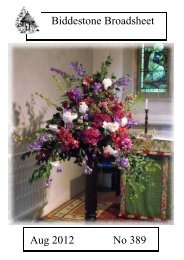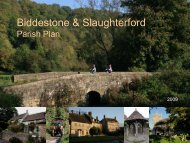ABSOLUTELYFINALPLAN1stJune09 AW.pdf - Biddestone Village
ABSOLUTELYFINALPLAN1stJune09 AW.pdf - Biddestone Village
ABSOLUTELYFINALPLAN1stJune09 AW.pdf - Biddestone Village
You also want an ePaper? Increase the reach of your titles
YUMPU automatically turns print PDFs into web optimized ePapers that Google loves.
History of the Parish continuedThis and its continuation eastwards, at firstunder the green before emerging in thegarden of Willowbrook, are called theWavering Brook and it joins up with theRiver Avon.The Methuen Family eventually becameLords of the Manor of <strong>Biddestone</strong>. Tithesfrom the two churches in <strong>Biddestone</strong>, StNicholas and St Peter, were made over byQueen Matilda (the wife of King Stephen)to the Priory at Monkton Farleigh as werethose from St Nicholas in Slaughterford.The church of St Peter, which was in thegrounds of the Manor House, was pulleddown during the 19 th century having beenin a state of decay for many years.<strong>Biddestone</strong> has primarily been anagricultural community. The populationonly grew from 331 to 483 between 1801and 1951. The two churches and a 15thcentury manor house, now Manor Farm,may once have been the only stoneedifices. Some of the wood and thatchbuildings would have housed workersfrom the woollen, domestic service andfarm trades. Fields were unfenced exceptfor portable hurdles, organised in strips,with the produce and livestock beingshared by landlord and tenant.The ponds behind the old Manor Housewere established in 1661. The buildingaround The Green that unifies the villagetoday did not take place until the late 17thor early 18th century. Britain's prosperity atthe time financed the rebuilding of'<strong>Biddestone</strong> Manor' and 'Pool Farm'together with the range of stone housesand cottages along the access roads andaround The Green.„Willow House‟ from 1730 was theculmination of this trend. Maltster SamuelAlborne created a typical Georgiantownhouse in this rural setting.The 'Old West Road' (now A420) bypassedthe site well to the north but more efficientsurfaces for wheeled vehicles were madeto it, and a new link with nearby Corshamas the track to Hartham declined, due tothe 'emparkment' of the estate there.<strong>Biddestone</strong> was self-sufficient at this time.Houses such as 'The Old Forge', 'The LittleHouse' and 'The Close' belie their formerfunctions as blacksmith's workplace,shop/slaughterhouse/coal merchants andagricultural machinery foundryrespectively.Bread was baked locally in 'The OldBakehouse'. Other buildings were farms,barns and malt houses. Hurdles and cartswere built and repaired. A steam sawmillexisted in Sawmills Lane. Humblercottages (some demolished near the pumphouse) housed farm labourers and otherworkers.Houses Around the Green, <strong>Biddestone</strong>Centre: Willow House<strong>Biddestone</strong> & Slaughterford Parish Plan6






